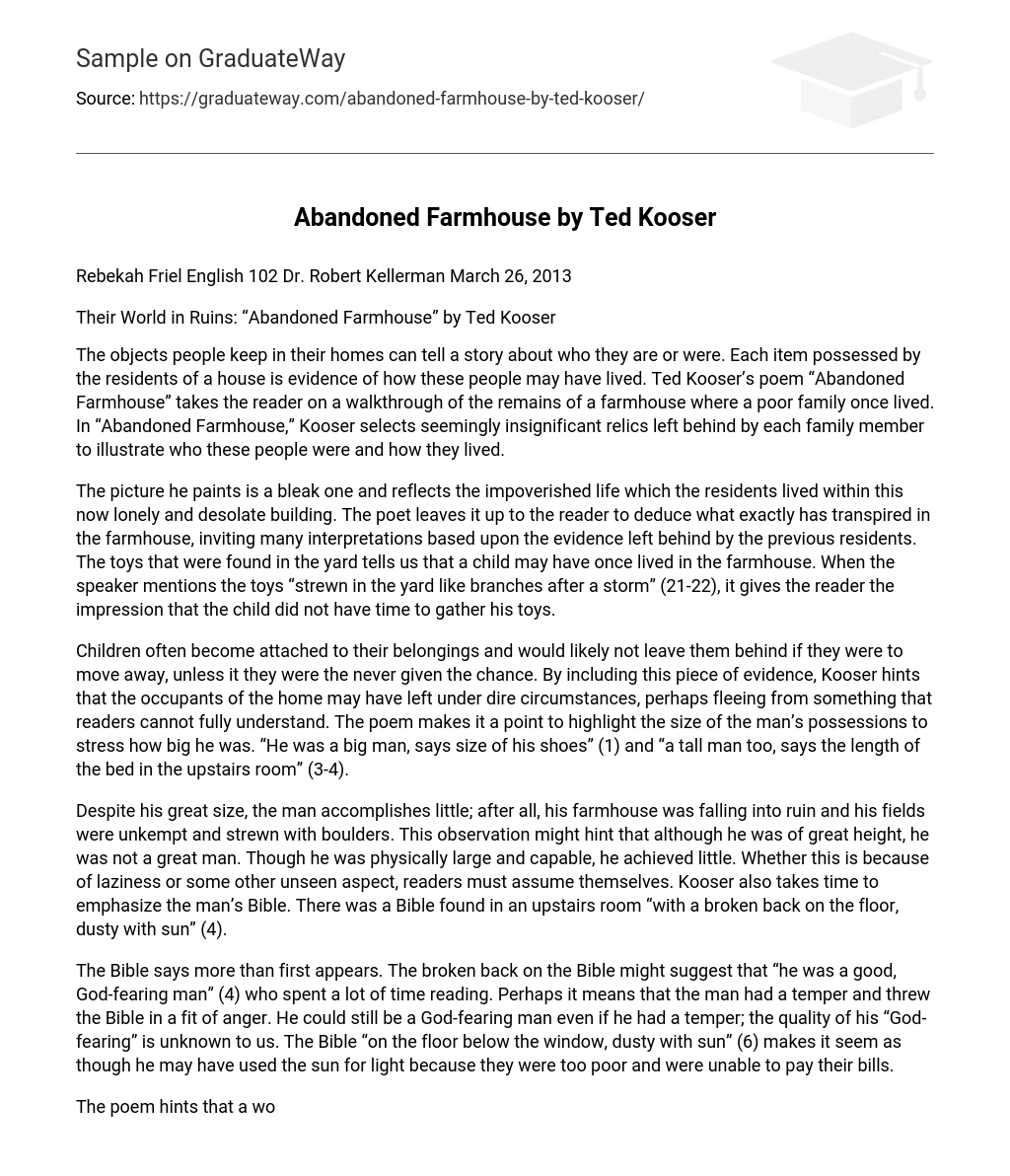The objects people keep in their homes can tell a story about who they are or were. Each item possessed by the residents of a house is evidence of how these people may have lived. Ted Kooser’s poem “Abandoned Farmhouse” takes the reader on a walkthrough of the remains of a farmhouse where a poor family once lived. In “Abandoned Farmhouse,” Kooser selects seemingly insignificant relics left behind by each family member to illustrate who these people were and how they lived.
The picture he paints is a bleak one and reflects the impoverished life which the residents lived within this now lonely and desolate building. The poet leaves it up to the reader to deduce what exactly has transpired in the farmhouse, inviting many interpretations based upon the evidence left behind by the previous residents. The toys that were found in the yard tells us that a child may have once lived in the farmhouse. When the speaker mentions the toys “strewn in the yard like branches after a storm” (21-22), it gives the reader the impression that the child did not have time to gather his toys.
Children often become attached to their belongings and would likely not leave them behind if they were to move away, unless it they were the never given the chance. By including this piece of evidence, Kooser hints that the occupants of the home may have left under dire circumstances, perhaps fleeing from something that readers cannot fully understand. The poem makes it a point to highlight the size of the man’s possessions to stress how big he was. “He was a big man, says size of his shoes” (1) and “a tall man too, says the length of the bed in the upstairs room” (3-4).
Despite his great size, the man accomplishes little; after all, his farmhouse was falling into ruin and his fields were unkempt and strewn with boulders. This observation might hint that although he was of great height, he was not a great man. Though he was physically large and capable, he achieved little. Whether this is because of laziness or some other unseen aspect, readers must assume themselves. Kooser also takes time to emphasize the man’s Bible. There was a Bible found in an upstairs room “with a broken back on the floor, dusty with sun” (4).
The Bible says more than first appears. The broken back on the Bible might suggest that “he was a good, God-fearing man” (4) who spent a lot of time reading. Perhaps it means that the man had a temper and threw the Bible in a fit of anger. He could still be a God-fearing man even if he had a temper; the quality of his “God-fearing” is unknown to us. The Bible “on the floor below the window, dusty with sun” (6) makes it seem as though he may have used the sun for light because they were too poor and were unable to pay their bills.
The poem hints that a woman lived with the man in the old farmhouse and that she appeared to be a homemaker. Kooser makes this known when the speaker mentions “the bedroom wall papered with lilacs and the kitchen shelves covered with oilcloth” (10-11). The food choices that the woman had available to feed the family really makes the reader think about the poverty that they may have lived: “money was scarce say the jars of plum preserves and canned tomatoes sealed in the cellar hole” (13-14). What food they had needed to last, as the man had failed to produce any food for his family in his untended fields.
The man living in the abandoned farmhouse was, in fact, not an effective farmer, “say the fields cluttered with boulders and the leaky barn” (7-8). It is a possibility that the man was a bad farmer. The history of the family is unknown. Something went wrong on that narrow country road, says the empty house in the weed-choked yard. Stones in the fields say he was not a farmer; the still sealed jars in the cellar say she left in a nervous haste (14-17). The fate of the family is left ambiguous. It is up to the reader to decide what happened to them. Many questions are raised from the reading. It is unclear why the family left their house.
A very inquisitive line is “she left in a nervous haste” ( This line leads the reader to believe that she may have left alone without her child. It would be hard to believe that a mother would leave her child behind. The reasons why she left are unknown. Foreclosure is ruled out because it does not say they left in a nervous haste. The word nervous would make sense their house was foreclosed, but they should not have left in a haste because they should have had plenty of time to gather their belongings. Since it appears that she left alone (or hopefully with the child), that raises the question about the farmer’s possible temper.
Maybe the husband did, in fact, have a temper and she could not handle it anymore; that would explain her being nervous and leaving in a haste. She may have run off with the child and left the man alone. The poem does mention that he was a “big” and “tall” man. This would make him very intimidating and possibly hard to live with if he had a temper. The woman and child may have felt threatened in their own home and needed to escape from the dreadful farm and the lonely, narrow country road.





